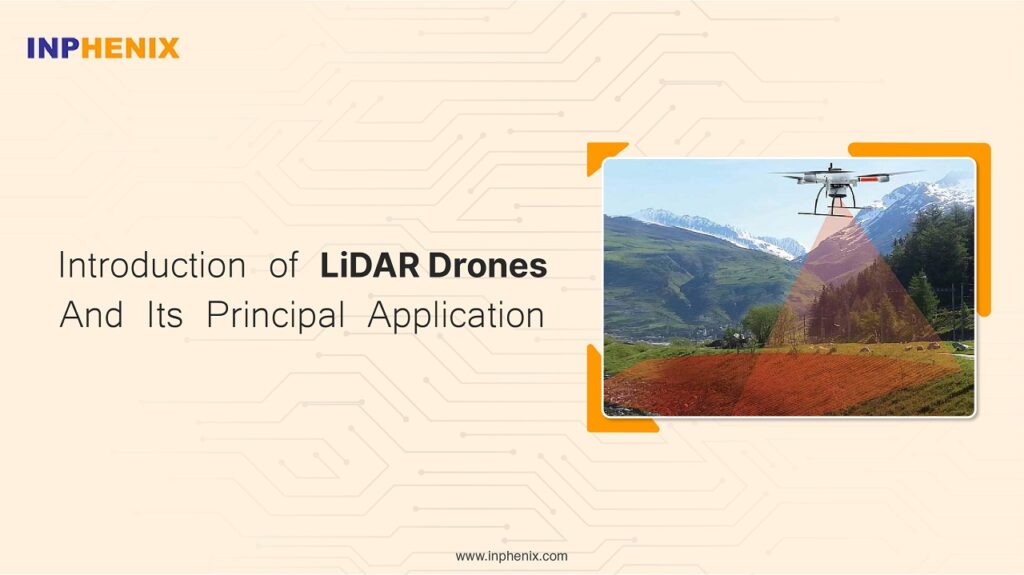
Light detection and ranging, or Lidar laser, is a remote sensing technique that is increasingly being used in conjunction with drones. One can calculate the distance to the earth’s surface by using the speed of light, measuring the two-way travel time from the scanner’s laser beam, and creating a 3D point cloud.
It is possible to distinguish real-life objects in LiDAR data because it is possible to determine which surface type the return came from based on the intensity of the return signal. This does closely match how much one would find in a picture.
Let’s look at some exciting applications in which LiDAR-equipped drones are useful. But first, let’s discover what LiDAR laser and LiDAR drones are.

Technology using LiDAR is quite recent. Engineers and land surveyors started using it to create maps of waterways, streams, and other geographic places in the early 1960s when it was initially invented.
When compared to other 3D modelling techniques like photogrammetry, which creates a detailed model by stitching together hundreds or even thousands of individual pictures, LiDAR is noticeably different.
Instead, LiDAR scans and measures a target from a distance using light energy and advanced lasers. A liDAR is a potent tool for finding new sites in an area like archaeology because When mounted to a high-flying drone, it can navigate around or over foliage and other obstacles in a way that photogrammetry devices cannot.
Any airborne drone with a LiDAR sensor attached is a LiDAR drone. The cost and size of LiDAR sensors have significantly decreased in recent years due to progress in the field of LiDAR technology, making it easier to mount a LiDAR payload on a drone.
Additionally, as LiDAR drones are used more frequently, the information they can deliver is both far more affordable and accurate. Also, due to improvements in the technology used to combine drones with LiDAR data, there has been a rapid increase in the number of businesses using drones with LiDAR such as 3D mapping.
For example, With an absolute precision of 4 inches horizontally and 2 inches vertically, a fixed-wing drone equipped with a LIDAR sensor can survey an area of up to four square miles in a single trip.
Let’s see some promising uses for drones with LiDAR technology.
LiDAR sensors are efficient in scanning surfaces, and being able to do so is extremely useful while carrying out search and rescue operations. These sensors can quickly identify individuals on any surface when attached to drones, helping rescue workers locate a missing person. Once the drone locates the victim, rescue personnel can decide how to bring them back safely.
It is simpler to conduct rescue operations at night because the sensor doesn’t need light to collect data. Drones with LiDAR capabilities are also helpful for performing tough water rescue operations. Drones can easily map and gauge the depth of aquatic bodies using hydrographic LiDAR sensors.
Although drones are widely utilised for surveillance and protection today, LiDAR sensors take this drone capability to a whole new level, assisting criminal justice organisations in conducting tactical assessments of huge areas. Officials can photograph and monitor crime scenes from a safe distance using drones equipped with LiDAR sensors.
Law enforcement officers are able to properly record scenes of the crime even if they take place in the dark and in remote locations because the sensor doesn’t need external light to capture the image. In order to better understand the timeline of events and present it as reliable evidence in a trial, the collected data can be reconfigured.
Drones equipped with LiDAR technology are proving to be incredibly helpful for guaranteeing site security and doing structural checks on construction sites. LiDAR sensors give a wide field of vision, precise distance measurements, and effective obstacle recognition, allowing consultants to conduct secure building evaluations. Additionally, using drones eliminates the need to manually survey the entire site. From the ground, inspectors can safely do an entire aerial inspection.
LiDAR drones can help locate hotspots in the structure when used in conjunction with thermal cameras, allowing inspectors to see problems early and take the required precautions to avert failure.
LiDAR drones are useful for a variety of smart agriculture because they make terrain mapping simple. By photographing the grazing area, drones with LiDAR sensors, for instance, can monitor cattle herds. Farmers are able to guarantee the safety of their herds in this way, even when it is dark outside.
Accurate mapping also enables farmers to employ precision farming techniques that improve crop yields and enable efficient crop monitoring. Farmers can determine the necessary quantity of fertilisers to achieve the desired yield by recording soil characteristics and crop data, such as crop height, volume, and mass.
Airborne Lidar drones can be employed to create a virtual terrain model or digital terrain model. To rapidly, precisely, and affordably create 3D digital terrain models (DTM) of distant or difficult terrain, it may be mounted on drones. Depending on the size of the region being scanned, data can be collected using a drone, an aircraft, or a helicopter. Compared to helicopters or aircraft, drones are quicker and easier to deploy, which lowers costs and risk.
LiDAR lasers are among the most useful tools for remote sensing since they can accurately map environments in high resolution regardless of the weather. A variety of novel applications that were previously impractical or expensive are now possible when these sensors are integrated with drones. Only a small number of applications for LiDAR drones are shown in these examples.
Inphenix is a U.S. based manufacturer of light sources with a focus on a variety of optical components, including gain chips, distributed feedback lasers, swept source lasers, Fabry Perot lasers, and VCSELs. Our products are state-of-the-art, Innovative, and can work with a variety of devices.
